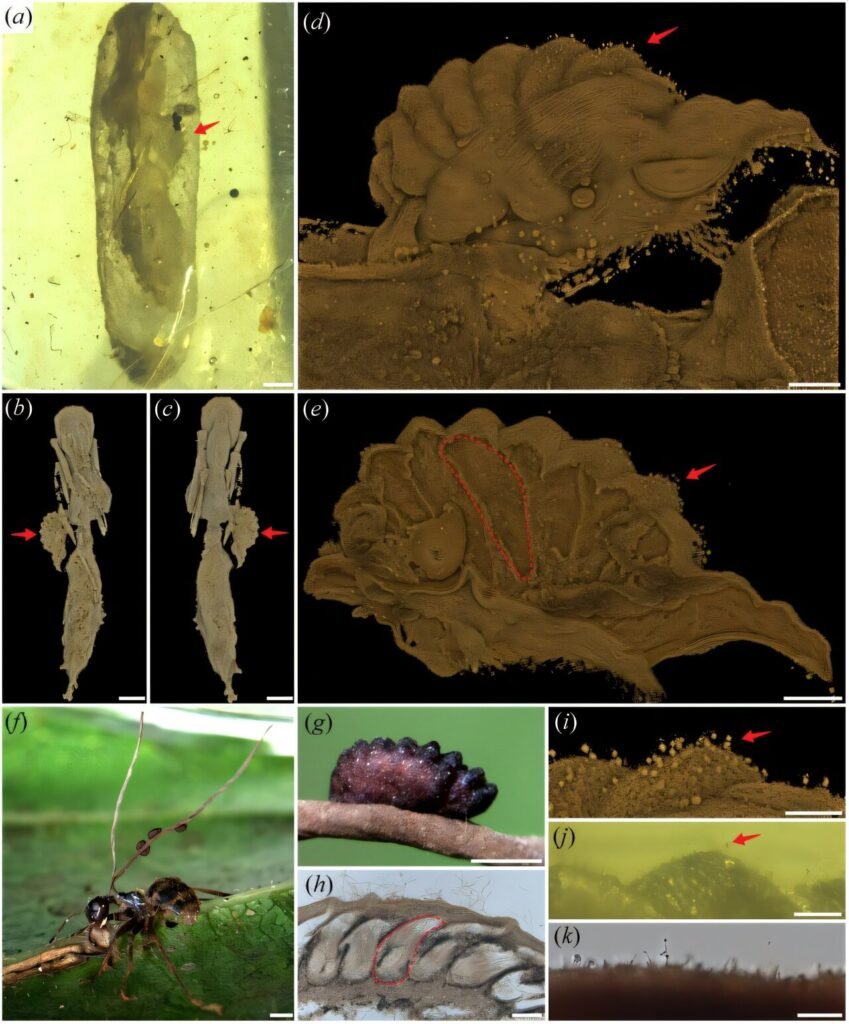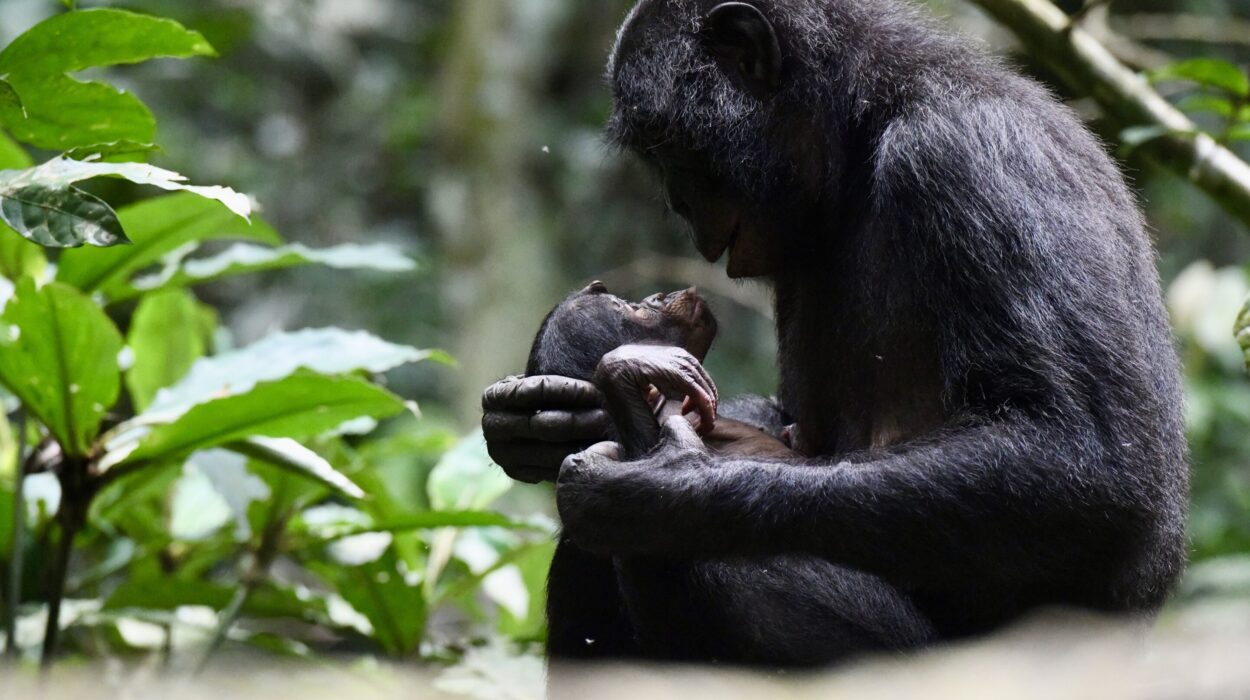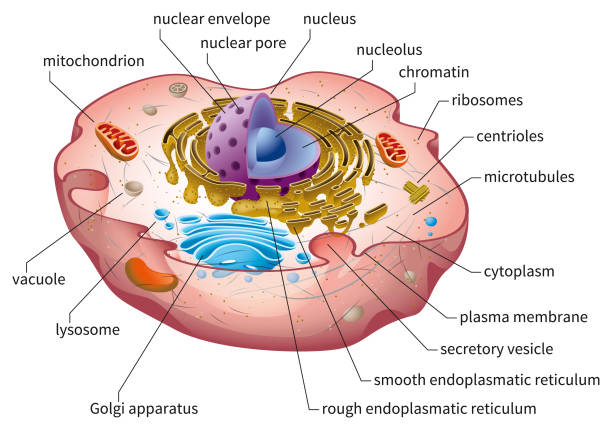In a jungle that no longer exists, under a humid Cretaceous canopy where dinosaurs thundered through the underbrush and flowering plants first began to bloom, a small drama unfolded—silent, slow, and deadly. Deep inside an ant colony, a parasite was taking hold. It infiltrated the soft tissues of an ant pupa, spreading like a whisper. Before the ant could ever become an adult, it was doomed—commandeered by a fungus that would hijack its body, consume it from the inside out, and use it as a launchpad to spread its spores.
Today, that ancient moment is frozen in time, captured in a droplet of golden amber. And it’s changing what we know about one of the strangest, most nightmarish chapters in the story of evolution.
In a new study published in Proceedings of the Royal Society B, researchers from the Chinese Academy of Sciences report the discovery of fossilized parasitic fungi in 99-million-year-old Burmese (Kachin) amber—providing the earliest direct evidence of entomopathogenic fungi infecting insects. These fungal assassins, the ancestors of today’s infamous “zombie ant” fungi, likely originated over 130 million years ago and quickly developed tactics that would forever alter the way life—and death—played out in the insect world.
The Fungi That Rewires the Mind
Entomopathogenic fungi are nature’s most sinister puppeteers. Today, one of their best-known representatives is Ophiocordyceps unilateralis, the fungus that turns tropical carpenter ants into unwilling agents of their own extinction. Once infected, the ant becomes little more than a host on autopilot, compelled to leave the safety of its colony, climb vegetation, and clamp its mandibles around a leaf or twig in a fatal grip. There, the ant dies, but the fungus lives on—bursting a stalk from the back of the ant’s head and showering spores onto the forest floor to infect others.
Similar phenomena occur across the insect kingdom. In grasslands, Entomophthora grylli infects crickets and grasshoppers, compelling them to climb to the tops of grasses before dying in dramatic poses—a phenomenon known as “summit disease.” In the corners of homes and barns, Entomophthora muscae drives houseflies to high perches before erupting through their exoskeletons. Even spiders are not safe. Some species of Ophiocordyceps turn arachnids into anchors for fungal reproduction, forcing them to spin webs in death before the fungus sprouts from their bodies.
These behaviors aren’t flukes. They’re evolutionary masterpieces—strategic manipulations of insect brains and bodies that maximize fungal reproduction. And now, thanks to a pair of fossilized specimens preserved in amber, scientists can trace the roots of this gruesome brilliance back tens of millions of years earlier than previously thought.
The Discovery in Ancient Amber
The newly discovered fossils were entombed in mid-Cretaceous amber from Myanmar, dated to approximately 99 million years ago. Among the most startling was a piece of amber containing a fossilized ant pupa, clearly infected by a fungus the researchers named Paleoophiocordyceps gerontoformicae. The ant, identified as a member of the extinct genus Gerontoformica, was likely parasitized inside its nest—a chilling reflection of behavior still observed in modern colonies today.

In many ant species, infected individuals are recognized and removed from the nest to protect the colony. The fossil suggests that this social immunity was already at play during the Cretaceous, with the infected pupa likely disposed of by worker ants before its fungal passenger had a chance to explode with spores.
What stunned researchers wasn’t just the preservation—it was the fungus’s eerie resemblance to modern Ophiocordyceps species. Morphological features, including lateral ascoma (fruiting bodies) and structures reminiscent of the asexual Hirsutella clade, hinted that the basic blueprint for insect zombification had already evolved during the age of dinosaurs.
Older Than Imagined, and Even More Clever
Previously, scientists estimated that Ophiocordyceps fungi originated around 100 million years ago. But based on phylogenetic reconstructions and these new fossil finds, the authors of the study suggest that the genus may have emerged much earlier—around 133 million years ago, in the early Cretaceous.
But this was no single-host story. According to the research, the earliest ancestors of Ophiocordyceps likely began by infecting beetles before shifting their sights to moths and, eventually, ants. These host shifts—documented through ancestral trait reconstructions—appear to have paralleled the explosive diversification of insect lineages during the same period.
In essence, as moths and ants grew in number and ecological importance, the fungi adapted to follow them. This predator-prey arms race didn’t just co-evolve—it co-optimized. The fungi evolved smarter, more specialized tools of manipulation, and the insects, in turn, developed new behaviors to detect, avoid, or quarantine the infection.
The evolutionary ballet between parasite and host was already in full swing when flowering plants were just beginning to dominate the landscape.
Evolution’s Most Grisly Innovation
The idea that a fungus can control the mind and body of an insect is already enough to send chills down the spine. But what’s truly astonishing is the elegance of the strategy. These fungi don’t just kill—they choreograph a death that benefits their species.
By hijacking insect motor functions and instincts, they ensure the host dies in precisely the right location and posture to optimize spore dispersal. For a fungus that relies on other insects stumbling upon its spores, getting the elevation and exposure just right can mean the difference between extinction and proliferation.
And they don’t just target ants. They’ve evolved unique manipulative tactics for flies, crickets, moths, beetles, and even spiders. This diversity of strategies, all with a common evolutionary goal, underscores the remarkable adaptive intelligence of these parasitic fungi.
They are, in a way, nature’s oldest behavioral hackers.
When Fossils Speak, We Listen
The study, titled “Cretaceous entomopathogenic fungi illuminate the early evolution of insect–fungal associations,” is more than just a documentation of ancient parasites. It fills a crucial gap in our understanding of how complex parasitic relationships evolve and persist across deep time.
Direct fossil evidence of entomopathogenic fungi is incredibly rare, primarily because fungi decay quickly and don’t fossilize easily—especially not in detail. But amber, the fossilized resin of ancient trees, provides a unique time capsule that occasionally preserves even the most delicate organisms in exquisite detail.
These new fossils offer a vivid snapshot of prehistoric life. They show us that the strange, shocking, and awe-inspiring interactions we see in today’s ecosystems have roots that stretch back into the primeval forests of the Cretaceous.
A New Chapter in the Story of Life
What makes this discovery so powerful is not just what it tells us about fungi or ants—but what it tells us about life itself. Parasitism is not a deviation from nature’s plan—it is nature’s plan. From viruses that infect bacteria to fungi that enslave ants, evolution has again and again found success through manipulation, adaptation, and specialization.
The zombifying fungi of today didn’t appear overnight. They are the product of millions of years of tinkering, testing, and terrifying innovation. And now, with a glimpse into amber’s golden lens, we know that this story is far older, and far more intricate, than we imagined.
So the next time you see a fly on a wall or an ant climbing a blade of grass, consider this: it may not be acting of its own accord. It could be following ancient instructions written not in its brain—but in the genes of a fungus older than the Tyrannosaurus rex.
Reference: Yuhui Zhuang et al, Cretaceous entomopathogenic fungi illuminate the early evolution of insect – fungal associations, Proceedings of the Royal Society B: Biological Sciences (2025). DOI: 10.1098/rspb.2025.0407






